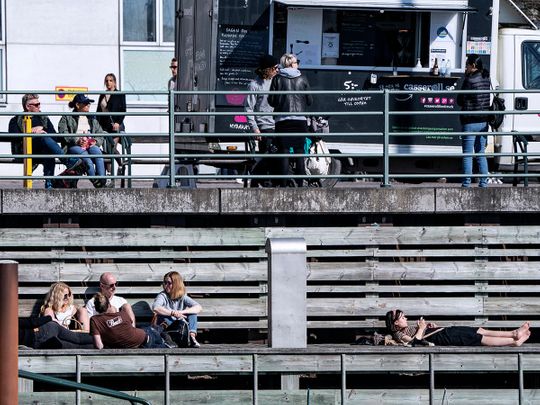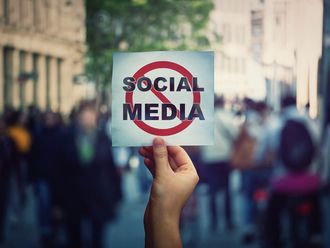
US president Donald Trump has often described this pandemic as our “war” with an “invisible enemy” — the coronavirus. That war metaphor is wrong and misleading.
Wars are fought and won by humans. So, we could out-mobilise the Nazis and Japanese to win World War II. US could out-spend and out-innovate the Soviet Union to win the Cold War.
But when you’re in a struggle with one of Mother Nature’s challenges — like a virus or a climate change — the goal is not to defeat her. No one can. She’s just chemistry, biology and physics.
This strategy posits that most people under age 65 who get the coronavirus — if they do not have major pre-existing medical conditions — will either experience it as a typical or tough flu, or completely asymptomatically, and the number who will get so sick that they require hospitalisation or emergency care will reliably be less than the number of beds needed to care for them
Mother Nature does not reward the strongest or the smartest. She rewards the species that are the most adaptive in evolving the chemistry, biology and physics that she has endowed them with to thrive — no matter what she throws at them.
Adapting to coronavirus
And that’s why I believe one of the most important questions we need to answer, as these lockdowns end, is this: Are we going to adapt to the coronavirus — — the way Sweden is attempting to do — or are we going to go the same direction as Sweden — — or are we just going to say “the hell with lockdowns” and go different ways?
In case you’ve missed it, Sweden has taken a radically different approach in dealing with the coronavirus. It has essentially opted for a strategy of “herd immunity” through exposure.
This strategy posits that most people under age 65 who get the coronavirus — if they do not have major pre-existing medical conditions — will either experience it as a typical or tough flu, or completely asymptomatically, and the number who will get so sick that they require hospitalisation or emergency care will reliably be less than the number of beds needed to care for them.
So, if you do your best to shelter and sequester all of those over 65 and those with serious pre-existing conditions — notably heart and lung disease and diabetes — and let much of the rest of the population circulate and get exposed and become naturally immune, once about 60% of your population has gone through this you’ll have herd immunity and the viral transmission will be blocked. (This assumes that immunity for some period of time results from exposure, as most experts think it will.)
Sweden's strategy
The upside of Sweden’s strategy — if it works — is that your economy does not take such a deep hit from lockdowns. It is unlike the strategy of suppression pursued in cities across America right now where, when the lockdown is over, your population largely has not developed immunity and so most everyone remains vulnerable to the virus, and to a second wave in the fall.
Think of the challenge of New York City. Its hospitals would have been overwhelmed by the sudden crush of patients, so the months of lockdown of millions will surely, and vitally, have saved lives.
But it has come at huge cost to jobs and businesses and with little progress to herd immunity — and with the prospect that the virus can come roaring back as soon as the lockdown is lifted, unless there is Chinese-level testing, tracking, tracing and quarantining those carrying the infection. And even that might not work.
Now think of Stockholm. Anders Tegnell, chief epidemiologist at Sweden’s Public Health Agency — the nation’s top infectious disease official and architect of Sweden’s coronavirus response — said in an interview: “We think that up to 25% people in Stockholm have been exposed to coronavirus and are possibly immune.
A recent survey from one of our hospitals in Stockholm found that 27% of staff there are immune. We think that most of those are immune from transmission in society, not the workplace. We could reach herd immunity in Stockholm within a matter of weeks.”
Navigating through the pandemic
Tegnell explains that Sweden is not just blithely letting all Swedes get the disease to achieve herd immunity but rather is pursuing a designed strategy for the most sustainable way to navigate through this pandemic.
So colleges and high schools are closed, but kindergarten through grade nine are open, as are many restaurants, stores and businesses.
But the government has also issued social-distancing guidelines, which many people are abiding by, encouraged working from home and discouraged non-essential travel.
Most important, it has encouraged everyone over 70 to stay at home and banned gatherings of more than 50 people and visits to nursing homes.
The result, so far, Tegnell noted, has been a gradual building of herd immunity among those least vulnerable while the country has avoided mass unemployment and an overwhelming of the hospital system.
It has come with a high cost, though. Sweden has a population of 10 million people, about twice as large as its nearest Scandinavian neighbours. As of April 28, the country’s COVID-19 death toll reached 2,274, about five times higher than in Denmark and 11 times higher than in Norway.
As for experts who warn that it has not been conclusively proven that individuals who have had COVID-19 are immune, by the presence of antibodies, from getting the virus again, Swedish researchers say that such thinking undermines the argument for looking for a vaccine: “If you can’t get population immunity, how can we then think a vaccine will protect us?”
Tegnell concluded: “What’s happening now is that many countries are starting to come around to the Swedish way. They are opening schools, trying to find an exit strategy. It comes back to sustainability. We need to have measures in place that we can keep on doing over the longer term, not just for a few months or several weeks.”
Asked about the American approach, he said that it “seems to me that the Americans let coronavirus go too far before any real strategy came into place.”
Here’s the stone-cold truth: There are only different hellish ways to adapt to a pandemic and save both lives and livelihoods.
Magic balance
I raise Sweden not because I think it has found the magic balance — it is way too soon to tell — but because I think we should be debating all the different ways and costs of acquiring immunity.
When we look across America, for instance, and see governors partly lifting lockdowns — because they feel their people just can’t take it anymore for economic or psychological reasons, even though their populations have little or no immunity — I worry we may end up developing more herd immunity but in a painful, deadly, costly, uncoordinated way that still leaves room for the coronavirus to strike hard again and overwhelm hospitals.
Michael Osterholm, director of the Centre for Infectious Disease Research and Policy at the University of Minnesota, said in an interview that “I think that Sweden is one model we need to look at, but it’s not the only model, but we surely need to have these discussions.”
Because absent a miracle vaccine soon, said Osterholm, “this virus will not stop trying to infect people until we get it to at least the 60% or 70% level.”
Herd immunity “has historically been nature’s way of ending pandemics,” added Dr. David Katz, the public health physician who helped kick off the debate in an essay he wrote.
“We need to bend with her forces — even when we as a species are responsible for unleashing them,” Katz said.
That means a designed strategy, based on risk profiles, of phasing back to work those least vulnerable, so we gradually cultivate the protection of herd immunity — “while concentrating our health services and social services on protecting those most vulnerable” until we can sound the all-clear.
Thomas L. Friedman is a Pulitzer prize-winning journalist and author.
(NYT)








